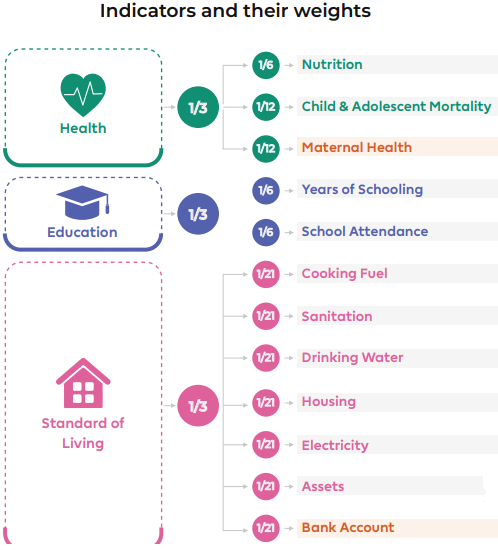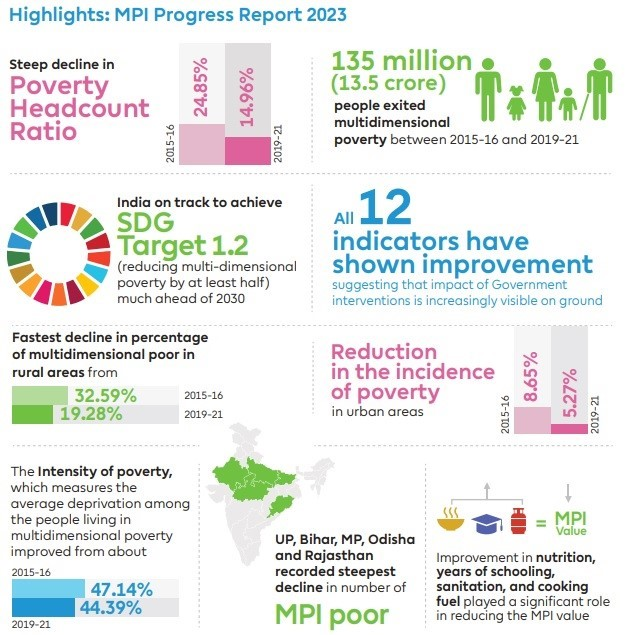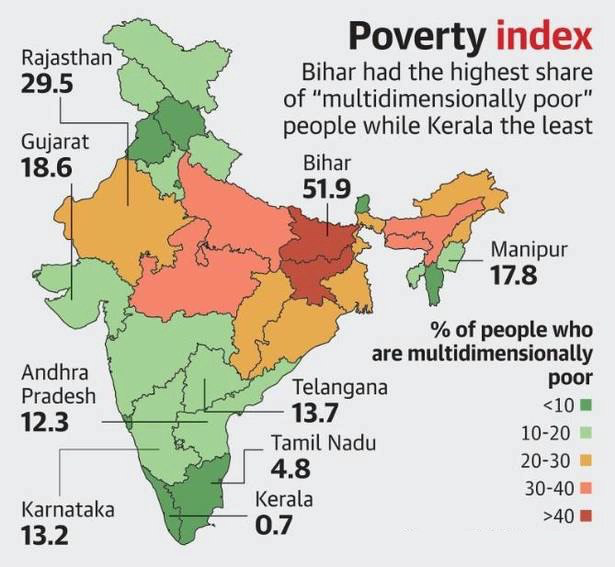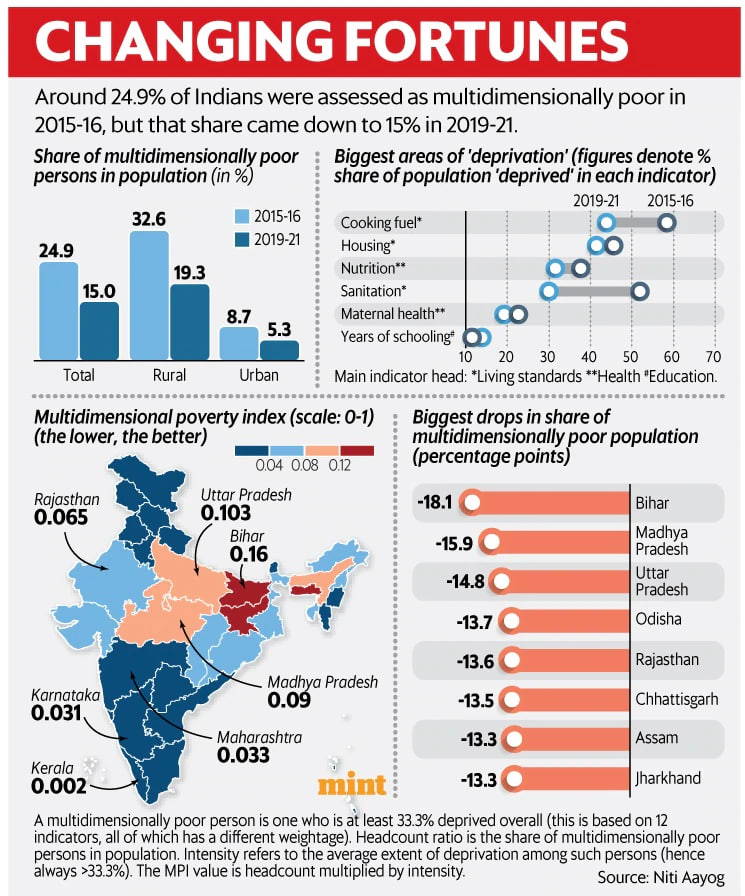Indian Economy
National Multidimensional Poverty Index, 2023
- 11 Oct 2023
- 15 min read
For Prelims: Sustainable Development Goals, Multidimensional poverty Index (MPI), National Family Health Survey, Health, NITI Aayog
For Mains: Importance of Eradicating Multidimensional Poverty in Achieving Sustainable Development Goals.
Context
Recently, NITI Aayog released National Multidimensional Poverty Index (MPI): A Progress Review 2023. This index is an important tool that enables the country to track its progress towards the Sustainable Development Goals (SDGs), particularly SDG target 1.2, that aims to reduce poverty in all its dimensions.
- Using the National Family Health Survey (NFHS), this report showcases India’s 2019-21 MPI results – plus, the progress in multidimensional poverty reduction between 2015-16 and 2019-21.
Note
- NITI Aayog took a significant step in 2021 by releasing the first ever MPI for India (based on NFHS 4). This initiative aims to improve India's position in globally accepted indices, underscoring the importance of comprehensive poverty alleviation efforts.
What is the Global Multidimensional Poverty Index?
- About:
- The Global MPI, captures overlapping deprivations in health, education, and living standards. It complements income poverty measurements because it measures and compares deprivations directly.
- The global MPI Report is jointly published by the Oxford Poverty and Human Development Initiative (OPHI) and the United Nations Development Programme (UNDP).
- The Global MPI, captures overlapping deprivations in health, education, and living standards. It complements income poverty measurements because it measures and compares deprivations directly.
- 2030 Agenda:
- Addresses Sustainable Development and the 17 SDGs related to the economic, environmental, and social aspects of societal well-being and are focused on the core principle of “leaving no one behind.”
What is the National Multidimensional Poverty Index?
- About:
- NITI Aayog, as the nodal agency for MPI, has been responsible for constructing an indigenised index for monitoring the performance of States and Union Territories (UTs) in addressing multidimensional poverty.
- In order to institutionalise this, NITI Aayog constituted an inter-ministerial MPI Coordination Committee (MPICC) including Ministries and departments pertaining to areas such as health, education, nutrition, rural development, drinking water, sanitation, electricity, and urban development, among others.
- MPI Coordination Committee (MPICC):
- Committee with support of others such as the survey implementers of the NFHS — International Institute for Population Sciences (IIPS) of Ministry of Health and Family Welfare, has been critical in developing the national MPI and ensuring its technical rigour and robustness.
- It also included experts from the Ministry of Statistics and Programme Implementation (MoSPI) and technical partners – OPHI and UNDP. The composition of the MPICC drew from the multidimensional nature of the indicators and sub-indicators within the index.
- This brought forth cross-sectoral perspectives on policies and interventions needed to improve achievements at the level of households.
- History of Poverty Measurement:
- In 1901, Dadabhai Naoroji's book titled 'Poverty and Un-British Rule in India' marked the earliest attempts to estimate poverty based on the cost of a subsistence diet.
- Subsequently, the National Planning Committee in 1938, and the authors of the Bombay Plan in 1944, proposed poverty estimations based on the minimum standard of living.
- Poverty estimation continued to have significant importance post-independence, and various expert groups worked on this issue. Early efforts included the Working Group in 1962, Dandekar and Rath in 1971, and the Task Force on "Projections of Minimum Needs and Effective Consumption Demand" led by Dr. Y. K. Alagh in 1979.
- Subsequently, expert groups headed by Lakdawala (1993), Tendulkar (2009), and Rangarajan (2014) continued this exercise of estimating monetary poverty based on consumption and expenditure surveys.
What are the Dimensions for National Multidimensional Poverty Index?
- Dimensions:
- Like the global MPI, India’s national MPI has three equally weighted dimensions – Health, Education, and Standard of living – which are represented by 12 indicators.
- Sub-indices of the National MPI:
- Headcount Ratio (H): How many are poor?
- Proportion of multidimensionally poor in the population, which is arrived at by dividing the number of multidimensionally poor persons by total population.
- Intensity of Poverty (A): How poor are the poor?
- Average proportion of deprivations which is experienced by multidimensionally poor individuals. To compute intensity, the weighted deprivation scores of all poor people are summed and then divided by the total number of poor people.
- MPI value is arrived at by multiplying the Headcount Ratio (H) and the Intensity of Poverty (A), reflecting both the share of people in poverty and the degree to which they are deprived.
- Headcount Ratio (H): How many are poor?
What are the Highlights of the Report ?
- Key Results – Steep Decline in Poverty:
- India has achieved a remarkable reduction in its MPI value and Headcount Ratio between 2015-16 and 2019-21, indicating success of the country’s commitment and action to address the multidimensional nature of poverty through its multisectoral approach.
- Uttar Pradesh (UP), Bihar, Madhya Pradesh (MP), Odisha and Rajasthan recorded steepest decline in number of MPI poor.
- Improvement in nutrition, years of schooling, sanitation, and cooking fuel played a significant role in reducing the MPI value.
- The MPI estimates highlight a near-halving of India’s national MPI value and decline in the proportion of population in multidimensional poverty from 24.85% to 14.96% between 2015-16 and 2019-21.
- This reduction of 9.89 % in multidimensional poverty indicates that, at the level of projected population in 2021, about 135.5 million persons have escaped poverty between 2015-16 and 2019-21.
- It is a major contribution towards achieving SDG target 1.2
- This indicates that India is well on course to achieve the SDG target 1.2 much ahead of 2030. At the same time, the Intensity of Poverty, which measures the average deprivation among the people living in multidimensional poverty also reduced from 47.14% to 44.39%.
- India has achieved a remarkable reduction in its MPI value and Headcount Ratio between 2015-16 and 2019-21, indicating success of the country’s commitment and action to address the multidimensional nature of poverty through its multisectoral approach.
- Disparities Across Rural and Urban Areas:
- While disparities in multidimensional poverty still exist between rural and urban areas, with the proportion of multidimensional poor in 2019-21 being 19.28% in rural areas compared to 5.27% in urban areas, the reduction in the MPI value has been pro-poor in absolute terms.
- The estimates indicate that rural areas saw a faster reduction in their MPI value, compared to urban areas. The incidence of poverty fell from 32.59% to 19.28% in rural areas compared to a decline from 8.65% to 5.27% in urban areas between 2015-16 and 2019-21.
- Fastest Absolute Reduction in MPI (State-wise):
- In terms of number of MPI poor, UP topped the list with 3.43 crore people escaping multidimensional poverty in the last five years, followed by Bihar (2.25 crore) and Madhya Pradesh (1.36 crore).
- Bihar, the state with the highest MPI value in NFHS-4 (2015-16), saw the fastest reduction in MPI value along with UP and MP.
- Comparative Performance of Districts in the MPI Score:
- An important characteristic of the MPI is its ability to provide estimates at the district level.
- The disaggregated estimates show that the most rapid reduction in the proportion of multidimensionally poor individuals occurred in districts located within the states of MP, Gujarat, UP, and Rajasthan.
- Indicator-wise Comparison of Deprivations:
- All the 12 indicators across the three dimensions – Health, Education and Standard of living – saw statistically significant reduction across the two time periods.
- Deprivations in sanitation (reduction by 21.8 % points) and cooking fuel (reduction by 14.6 % points) fell the most during the period from 2015-16 to 2019-21.
- Overall, progress in nutrition, years of schooling, sanitation, and cooking fuel has been the significant contributor to the decline in MPI value.
What is the Significance of National Family Health Surveys in MPI?
- Global MPI:
- The global MPI is constructed using Demographic and Health Surveys (DHS) in countries where it is available.
- DHS follows a standardised survey methodology and guidelines for collection of data for indicators that allows for cross-country comparisons of the indicators of the MPI.
- It also allows multiple levels of disaggregation either geographically or by population sub-groups.
- The global MPI is constructed using Demographic and Health Surveys (DHS) in countries where it is available.
- National MPI:
- The DHS for India is the NFHS, which is conducted by the IIPS under the aegis of the Ministry of Health and Family Welfare (MoHFW).
- The latest iteration of national MPI is based on the NFHS-5 conducted through 2019-21 and is comparable with the baseline statistics of the national MPI computed using the data from the NFHS-4 conducted through 2015-16.
- The data for both the surveys are representative at national, state and district levels. The NFHS-4 provided representative data for urban and rural areas up to the district level, while the NFHS-5 provides representative data for urban and rural areas up to the level of States and Union Territories.
What is the Outcome of the Report by NITI Aayog?
- National MPI:
- Report underlines the Government’s commitment to understanding, measuring, and addressing the many dimensions of poverty and leveraging this understanding as a key tool in policymaking.
- Baseline Report:
- The baseline report of the national MPI has been pivotal in raising awareness among state governments, academia, civil society, and citizens about the significance of using multidimensional poverty measures.
- Ministries/Departments:
- Taking into account their priorities and development challenges, various Ministries/Departments have prepared action plans. More than 50 reform actions have been identified in 16 reform areas such as nutrition, financial inclusion, education, rural development, and housing among others.
- Collaboration with States:
- Ministries have started implementing these reforms. India’s stellar progress on the national MPI between 2015-16 and 2019-21 reflects the Government’s commitment to improving the quality of people’s lives.
- It became possible through targeted policies, schemes, and developmental programmes rolled out at both the national and sub-national levels.
- Investments:
- The Government’s focus on investments in critical areas of education, nutrition, water, sanitation, cooking fuel, electricity, and housing has played a pivotal role in driving these positive outcomes.
- Top-Down Approach:
- The findings from the second edition of the National MPI will serve as a valuable resource for States and UTs to identify and amplify actions right upto the district level.
- It will also enable them to track the progress of the vulnerable hotspots and pinpoint areas that require further targeted policy interventions and programmatic action.
- Key Government schemes that have contributed significantly in driving the tremendous progress presented in this report are:
What are the Steps taken to Reduce Multidimensional Poverty ?
- State Support Mission (SSM):
- It is an overarching umbrella initiative of NITI Aayog to reinvigorate its ongoing engagement with States and UTs. Under this mission, NITI Aayog supports the States/UTs in capacity building and setting up State Institutions for Transformation (SIT).
- SSM would facilitate the strengthening of SDG localisation efforts which in turn would aid further reduction in multidimensional poverty.
- Progress Dashboard:
- To effectively monitor the progress of implementation, a dashboard has been developed by the Development Monitoring and Evaluation Office (DMEO), an attached office under NITI Aayog, to leverage the monitoring of select Global Indices including MPI.
- This dashboard can track the progress of State-led reforms aimed at improving outcomes for a reduction in multidimensional poverty.
- The data from this edition of the national MPI will also be made available to States on the dashboard to enable real-time tracking of multidimensional poverty across various indicators.







.png)



